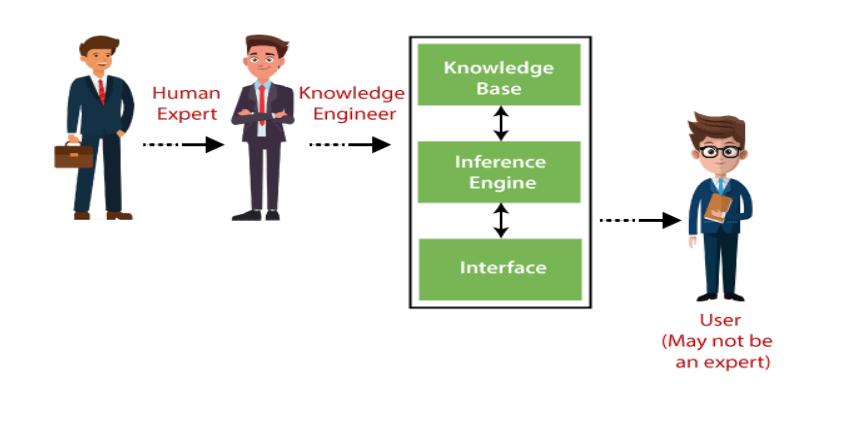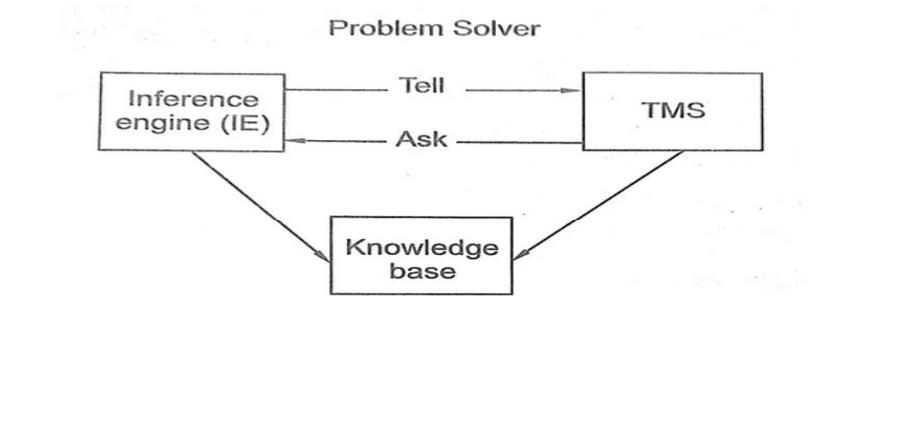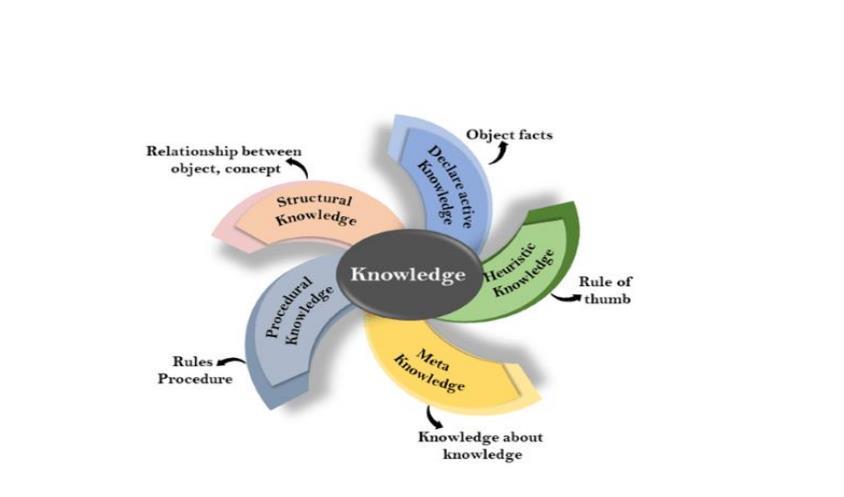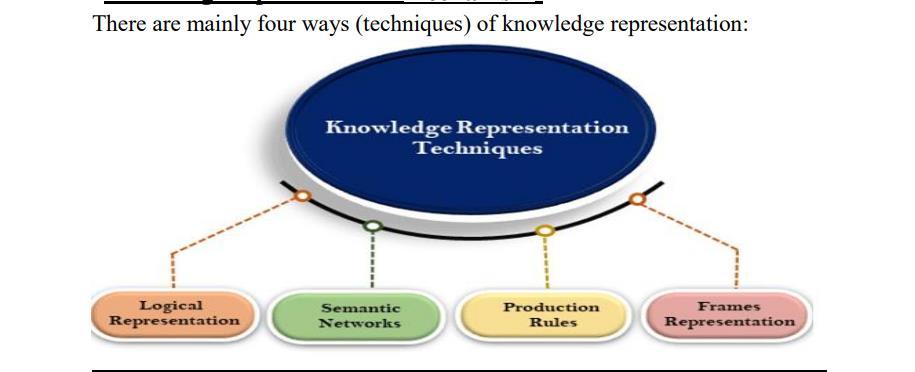AI_6(2)
Q -> Ex the expert system & various components with the help of block dig?
An expert system is a computer program designed to solve complex problems and make decisions like a human expert.
extracting knowledge from its knowledge base using the reasoning and inference rules
Uses this knowledge to answer user queries and solve problems.
Helps in decision-making for complex issues using facts and heuristics.
Designed for specific fields like medicine, science, etc.
Performance depends on the amount of expert knowledge stored base.
The more knowledge stored in the KB, the more that system improves its performance.

1. User Interface
1.Users enter their questions or problems in a simple way.
2.The system sends these questions to the inference engine for processing.
3.After processing, the system shows the answers to the user.
2. Inference Engine(Rules of Engine):
The inference engine is like the brain of the expert system. It processes information and applies rules from the knowledge base. It finds answers and new information based on these rules.
Two types: Deterministic and Probabilistic.
Deterministic engine gives conclusions assumed to be true, based on facts and rules.
Probabilistic engine deals with uncertainty and gives conclusions based on probability.
3. Knowledge Base
The knowledge base is like a big storage unit that holds all the knowledge collected from experts in a specific field.
It's like a big database full of facts and rules about that topic It's also like a collection of things and their traits.
Q -> NOTE :
1. Characteristics of Expert System:
.High Performance: Expert systems has ability at solving complex problems in a specific area with efficiency and accuracy.
.Understandable: It responds in a way that can be easily understandable by the user. It can take input in human language and provides the output in the same way.
.Reliable: It is much reliable for generating an efficient and accurate output.
. Highly Responsive: : quickly respond to complex queries within avery short period of time
2. Knowledge engineering:
The knowledgebase is a type of storage that stores knowledge gathered from various experts in a specific field.
.It is considered as big storage of knowledge. It is similar to a database that contains information and rules of a particular domain or subject.
.can also view the knowledge base as collections of objects and their attributes.
AI_(5)
Q -> D - BETWEEN :-

Q -> Probabilistic reasoning:
Probabilistic reasoning uses probability to show uncertainty in knowledge representation.
It involves making decisions based on probabilities.
Probabilistic reasoning helps manage uncertainty caused by laziness or ignorance in a simple way.
Need of probabilistic reasoning in AI: When there are unpredictable outcomes.
Use When there are too many options or details to handle When an unknown error occurs during an experiment.
In probabilistic reasoning, there are two ways to solve problems with uncertain knowledge:
• Bayes' rule
• Bayesian Statistics
Q ->. Truth Maintenance
A truth maintenance system (TMS) helps AI manage inconsistent and uncertain information.
TMS detects and resolves conflicts between beliefs and assumptions. It ensures the AI system is aware of all its valid and up-to-date knowledge. TMS records beliefs, facts, and the reasoning behind them. When new information is added, TMS checks for consistency with existing beliefs.
TMS tracks dependencies between beliefs to maintain knowledge integrity. It can also be used in natural language processing, where it helps to ensure that the AI system is interpreting language correctly and consistently.

Q ->Ex concept of reasoning in AI with the help of different types of reasoning?
Reasoning plays a great role in the process of artificial Intelligence.
In artificial intelligence, reasoning is very important because to understand the human brain
Types of reasoning’s:
• Deductive reasoning
• Inductive reasoning
• Abductive reasoning
• Common Sense Reasoning
• Monotonic Reasoning
• Non-monotonic Reasoning Sure, here's a simplified version:
1. **Deductive Reasoning**:
- Starts with general rules or principles.
- Uses those rules to reach a specific conclusion.
2. **Inductive Reasoning**:
- Observes specific instances or examples.
- Draws a general conclusion or pattern based on those observations.
3. **Abductive Reasoning**:
- Begins with an observation or set of observations.
- Makes an educated guess about the most likely explanation for those observations.
4. **Common Sense Reasoning**:
- Relies on everyday knowledge and intuition.
- Helps navigate daily life and make practical decisions.
5. **Monotonic Reasoning**:
- Conclusions remain unchanged with the addition of new information.
- Once a conclusion is reached, it doesn't alter, regardless of new facts.
6. **Non-monotonic Reasoning**:
- Conclusions can change when new information is added.
- More flexible and adaptive compared to monotonic reasoning.
AI_(3) Q -> Discuss knowledge representation issues?
• Humans are best at understanding, reasoning, and interpreting knowledge.
• Human knows things, which is knowledge and as per their knowledge they perform various actions in the real world.
• But how machines do all these things comes under knowledge representation and reasoning.
Represented in AI systems:
- Object: Descriptions of things in the world, like guitars having strings and trumpets being brass instruments.
- Events: Actions that happen in our world.
- Performance: Information about how to do things effectively.
- Meta-knowledge: Understanding what we know and how we know it.
- Facts: Statements that are true about the real world.
- Knowledge-Base: The main storage for information in AI systems, represented as KB.
- Knowledge: Awareness or understanding gained from experiences, facts, and situations. TYPES:

1. Declarative Knowledge: Knowing facts and concepts, expressed in simple sentences.
2. Procedural Knowledge: Knowing how to do things, using instructions.
3. Meta-knowledge: Knowing about other types of knowledge.
4. Heuristic Knowledge: Expert-based rules from experience, not always sure but often helpful.
5. Structural Knowledge: Understanding relationships between concepts, like how things are connected.
Q -> Explain knowledge representation mechanism|
KRR is about teaching AI to understand and use information, like diagnosing illnesses or chatting naturally.

1. **Semantic Network Representation**:
- Organizes concepts as nodes connected by relationships.
- Helps visualize connections between ideas.
2. **Logical Representation**:
- Uses formal symbols and rules to represent and reason about statements.
- Expresses relationships between facts using logic.
3. **Frame Representation**:
- Structures knowledge with entities, attributes, and values.
- Breaks down complex concepts into manageable units.
4. **Production Rules**:
- Conditional statements guiding actions based on conditions.
- Dictates behaviour in AI systems using rules.
Q -> Rules for Knowledge Representation:
- Rules guide AI actions based on conditions met.
- They're structured as "IF...THEN..." statements.
- Antecedent sets conditions; consequent specifies actions.
- Rules can have multiple conditions and actions.
- Conditions compare objects with values using operators.
- Conditions compare objects with possible values using operators like ">" or "is".
- For instance, "IF temperature > 30°C THEN turn on the fan."
- Rules help AI systems make decisions or draw conclusions based on specific circumstances.
- They're like instructions telling the system what to do when certain conditions are true.
- Conditions in rules compare objects with values using operators like ">", "is", or "equals to".
- These conditions might involve comparing numbers, text, or other data types.
- Based on these conditions, the system can take actions or draw conclusions to respond appropriately.
For example, suitable antecedents in a rule might be
• IF x > 3
• IF name is “Bob”
• IF weather is cold
• Here, the objects being considered are x, name, and weather; the operators are “>” and “is”, and the values are 3, “Bob,” and cold.
Q -> A Horn clause:
1. A Horn clause is like a rule in AI with conditions and outcomes.
2. It has either one positive condition or none at all.
3. These rules help computers make decisions based on specific situations.
4. If all conditions are true, then the result is also true.
5. Integrity constraints in Horn clauses help prove certain facts are false in all situations.
- Is a clause (a set of terms connected by "OR") with at most one positive (unnegated) term.
- Types:
- Definite clause/Strict Horn clause: Has exactly one positive term.
- Unit clause: Definite clause with no negative terms.
- Goal clause: Horn clause without a positive term.
- Horn Clausal form:
- NOT(P1) OR NOT(P2) OR ... OR NOT(Pn) OR Q can be transformed into P1 AND P2 AND … AND Pn => Q.
- NOT(P1) OR NOT(P2) OR ... OR NOT(Pn) can be transformed into P1 AND P2 AND … AND Pn =>.
- Integrity constraints:
- Allow the system to prove that some conjunction of atoms is false in all models of a knowledge base.
- Written as false ← a1 ∧ ... ∧ ak.
- A Horn clause is either a definite clause or an integrity constraint, with either false or a normal atom as its head.
Q -> Type of learning:
1. Supervised Learning:
2. Unsupervised Learning:
3. Semi-Supervised Learning:
4. Reinforcement Learning:
REFER ML NOTES
AI_(4)
Q -> Ex propositional logic & predicate logic.
Propositional logic (PL) deals with propositions, which are declarative statements that are either true or false.
It's a method of knowledge representation in logical and mathematical form.
Propositional logic is also called Boolean logic as it works on 0 and 1.
Propositional logic consists of an object, relations or function, and logical connectives.
These connectives are also called logical operators.
A proposition formula which is always true is called tautology, and it is also called a valid sentence.
A proposition formula which is always false is called Contradiction.
Syntax:
Syntax defines the allowable sentences in propositional logic, including atomic and compound propositions.
TYPE (DIAGRAM)
• Atomic Propositions :
- Atomic propositions are simple statements.
• Compound propositions
- Compound propositions are formed by combining atomic propositions with logical connectives.
Predicate Logic:
• Predicate Logic deals with predicates, which are propositions, consist of variables
A predicate is an expression of one or more variables determined on some specific domain.
A predicate with variables can become a proposition by assigning a value to the variable or by quantifying it.
Examples of predicates:
• Consider E(x, y) denote "x = y"
• Consider X(a, b, c) denote "a + b + c = 0"
• Consider M(x, y) denote "x is married to y."
Q -> Illustrate infrance rule & various types of infrance. rule with the help of example
The inference rule in logic helps us figure out new things based on what we already know. Inference rules are the templates for generating valid arguments.
1. **Modus Ponens:**
- If I'm sleepy (P) and if being sleepy means I go to bed (P → Q), then I'll go to bed (Q).
2. **Modus Tollens:**
- If I don't go to bed (~Q) and if being sleepy means I go to bed (P → Q), then I'm not sleepy (~P).
3. **Hypothetical Syllogism:**
- If having my home key (P) means you can unlock my home (P → Q), and if unlocking my home (Q) means you can take my money (Q → R), then having my home key (P) means you can take my money (P → R).
4. **Disjunctive Syllogism:**
- If today is Sunday or Monday (P ∨ Q), and today is not Sunday (¬P), then today is Monday (Q).
5. **Addition:**
- If I have vanilla ice-cream (P), then I have vanilla or chocolate ice-cream (P ∨ Q).
6. **Simplification:**
- If I have both vanilla and chocolate ice-cream (P ∧ Q), then I have vanilla ice-cream (P) or I have chocolate ice-cream (Q).
7. **Resolution:** - If it's either sunny or rainy (P ∨ Q) and it's not sunny but windy (¬P ∧ R), then it's either rainy or windy (Q ∨ R).
Q -> Demonstrate first order predicate logic with its Syntax & semantics.
First-order logic is another way of knowledge representation in artificial intelligence. It is an extension to propositional logic.
FOL is sufficiently expressive to represent the natural language statements in a concise way
First-order logic is also known as Predicate logic or First-order predicate logic.
First-order logic makes it easier to describe objects and their relationships in a powerful way.
Objects: A, B, people, numbers, colors, wars, theories, squares, pits, Wumpus
Relations: It can be unary relation such as: red, round, is adjacent, or n-any relation such as: the sister of, brother of, has color, comes between.
Function: Father of, best friend, third inning of, end of, ......
• As a natural language, first-order logic also has two main parts:
• Syntax
• Semantics
The syntax of First-Order Logic defines which symbols form valid logical expressions, employing shorthand notation for statements.
Q -> Illustrate first order predicate logic & cortifier st order predicate logic
**First-Order Predicate Logic:**
- **Objects:** People, numbers, colors, etc.
- **Relations:** Unary (e.g., isRed) or n-ary (e.g., isSiblingOf).
- **Functions:** e.g., fatherOf, bestFriendOf.
**Syntax:**
- **Terms:** Constants, variables, functions.
- **Predicates:** Statements about objects (e.g., P(x)).
- **Quantifiers:**
- **Universal (∀):** "For all" (e.g., ∀x P(x)).
- **Existential (∃):** "There exists" (e.g., ∃x P(x)).
- **Connectives:** ∧ (and), ∨ (or), ¬ (not), → (implies), ↔ (if and only if).
**Example Statements:**
- Atomic: \( \text{Brother}(Ravi, Ajay) \)
- Complex: \( \forall x (\text{Cat}(x) \rightarrow \text{Animal}(x)) \)
**Semantics:**
- **Interpretation:** Assigns meaning to symbols.
- **Satisfaction:** A formula is satisfied if true under an interpretation.
- **Validity:** A formula is valid if true under all interpretations.
First-order logic statements can be divided into two parts:
• Subject: Subject is the main part of the statement.
• Predicate: A predicate can be defined as a relation, which binds two atoms together in a statement.

